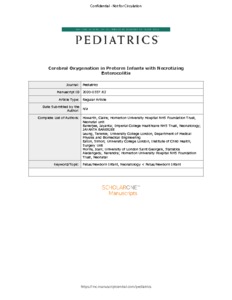Howarth, C; Banerjee, J; Leung, T; Eaton, S; Morris, JK; Aladangady, N
(2020)
Cerebral Oxygenation in Preterm Infants with Necrotizing Enterocolitis.
PEDIATRICS, 146 (3).
e20200337.
ISSN 0031-4005
https://doi.org/10.1542/peds.2020-0337
SGUL Authors: Morris, Joan Katherine
![[img]](https://openaccess.sgul.ac.uk/112205/1.hassmallThumbnailVersion/Revised%20and%20final%20documents%20all%20submitted%2011th%20June.pdf)  Preview |
|
PDF
Accepted Version
Available under License ["licenses_description_publisher" not defined].
Download (645kB)
| Preview
|
Abstract
BACKGROUND AND OBJECTIVES: Preterm infants with necrotizing enterocolitis (NEC) are known to have worse neurodevelopmental outcomes, but there is no substantial evidence to support an underlying pathophysiology. We aimed to examine whether cerebral oxygenation differs in those infants who develop NEC compared to cerebral oxygenation in those who do not.
METHODS: We examined 48 infants <30 weeks’ gestation admitted to a tertiary level NICU from October 2016 to May 2018. Infants with birth weight less than or equal to the second percentile, abnormal antenatal dopplers or twin-to-twin-transfusion-syndrome were excluded. Cerebral oximetry measurements were performed by using a near-infrared spectroscopy (NIRS) monitor weekly for 60 minutes, allowing measurement of cerebral tissue oxygenation index from the first week of life to 36 weeks postconceptional age. Weekly clinical status was also recorded. NEC was defined as greater than or equal to Bell stage 2.
RESULTS: The median birth weight was 884 g (range of 460–1600 g), the median weeks’ gestational age was 26 + 3/7 (23 + 0/7 to 29 + 6/7), and 52% were girls. In total, 276 NIRS measurements were completed, and 7 infants developed NEC. NIRS measurements from 1 infant with NEC and 4 infants without NEC who developed hemorrhagic parenchymal infarcts were excluded from analysis. Infants who developed NEC had significantly lower cerebral tissue oxygenation index than those who did not (P = .011), even when adjusted for confounders, including gestational age, birth weight, patent ductus arteriosus, enteral feeds, sex, ethnicity, and hemoglobin.
CONCLUSIONS: Infants with NEC have significantly lower cerebral tissue oxygenation throughout their neonatal intensive care stay in comparison with those who did not develop NEC. This is a novel finding and could explain their worse neurodevelopmental outcome.
Statistics
Item downloaded times since 04 Sep 2020.
Actions (login required)
 |
Edit Item |


